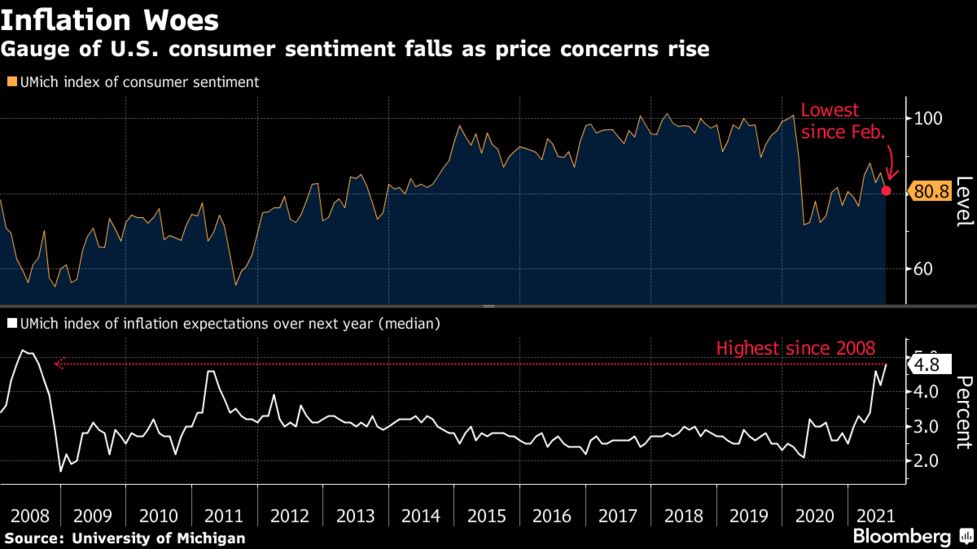Weakening Consumer Sentiment Surprises Economists
Disclosure: We are reader-supported. If you purchase from a link on our site, we may earn a commission. Learn more
This past week saw economists' expectations on the important economic indicator of consumer sentiment confounded. They had been anticipating a positive rise in the crucial economic metric. Instead, consumer sentiment weakened significantly in the first half of the month of July. At the same time, the consumer price index measurement of inflation increased, setting a new over decade long record for its rise in the process.
Consumer Sentiment Measurement Weakens Against Economists' Expectations
The University of Michigan released its closely followed consumer sentiment index for July. Results came out at 80.8 for the timeframe covering the first half of the month of July. This figure followed the prior month's release of 85.5. Economists were surprised as they had been looking for an increase in the headline number.
Friday's release revealed other troubling economic news, showing that consumers' expectations are now for inflation to rise going forward. They now anticipate prices will go up by 4.8 percent over the coming year. This is the highest projection going back to August of 2008. The graph below shows the results:

With the release of the surprising and disappointing data half an hour into the market open on Friday, investors quickly turned negative. The major indices closed at their session lows when markets had finished with the trading day. Senior U.S. Economist Andrew Hunter of Capital Economics commented on the weakness in consumer sentiment, stating that:
“It is at face value hard to square with the acceleration in employment growth and the continued resilience of the stock market. The report suggested that concerns over surging inflation are now outweighing those positive trends.”
Consumer Price Index Increase Sets A New 13 Year Long Record
The weaker than expected consumer sentiment followed on the heels of other disappointing data released last week. Last Tuesday's report on the consumer price index revealed an increase of 5.4 percent for June verses the same time period a year ago. It turned out to be the fastest rise in almost 13 years. Economists had been looking for a gain of a tamer five percent.
The Labor Department attritubed this higher than expected rise to several different components. Tracked data saw a marked jump higher in the costs of used vehicle prices as well as the important categories of both food and energy. This leap higher in the prices represented the biggest increase going all the way back to August in 2008 just ahead of the worst episode in the global financial crisis.
When the more volatile categories of food and energy were taken out of the inflation figure, the so-called core CPI still rose by 4.5 percent. This was also the most dramatic jump in this metric dating back to September of 1991. Surveyed economists had looked for a significantly lower print of only 3.8 percent. In monthly basis terms, the headline and core prices both increased by .9 percent versus economists' estimates of a significantly lower .5 percent.
Other data that came out ahead of the Friday market open was similarly troubling in being higher than anticipated. Retail and food service sales increased by .6 percent for June. Dow Jones surveyed economists had been expecing a .4 percent decline. Investors fretted over the results, sending the Dow down about 300 points by Friday's close. In the wake of the surprising inflation data releases, Senior Economist Sarah House of Wells Fargo's corporate and investment bank shared that:
“What this really shows is inflation pressures remain more acute than appreciated and are going to be with us for a longer period. We are seeing areas where there's going to be ongoing inflation pressure even after we get past some of those acute price hikes in a handful of sectors.”
Big Monthly Hike in Consumer Prices Translates to Negative Real Wages
The Labor Department administered Bureau of Labor Statistics came to another negative conclusion in a separate report it released the same day. This determined that the large monthly increase in the consumer prices equated to actual negative real wages being received by workers. Even while inflation was rising, the measure of real average hourly earnings declined by .5 percent on the month. This was thanks to the .3 percent increase that was seen in average hourly earnings being overcome by the increase in the CPI.
A few factors have been blamed for the runup in inflation. There has been incredibly high demand in general with the easing of the coronavirus pandemic at the same time as bottlenecks in the supply chain have appeared. Year over year comparisons have also been made against the point where the economy struggled to restart in the crisis' early months.
One silver lining in the disappoining data is that the policymakers still remain hopeful. The Federal Reserve as well as White House officials anticipate that these present inflation pressures will start to ease in coming months. Even so, officials at the U.S. central bank have already admitted that this inflation is both more enduring and stronger than they had initially expected. One senior level White House economic advisor shared anonymously that:
“We think it's very important to strip out the pandemic affected sectors. We're not saying that those pandemic related risks aren't real. We're not ignoring them, but we're also trying to put them into a longer term perspective, because the underlying price index outisde the pandemic affected areas is quite tame.”
Economist Sarah House of Wells Fargo shared her concerns regarding the inflation and its potential consequences with:
“This does increase some of the jitters among some [Fed] members. We already saw they were getting more woried about inflation at the June meeting. If you parse through this, there are a number of areas where inflation is picking up and likely has staying power. That's going to make some folks nervous.”
Shutdown Sectors Cause Much of the Price Pressures
A great deal of the pressure on prices has stemmed from those sectors that were hard hit by the pandemic shutdown. Three of these included transportation costs, air fares, and used car prices. June was a case in point. Used car and truck prices vaulted up 10.5 percent, creating over a third of all the gains in the price index. Looking back over the year long period, prices for used cars and trucks have roared 45.2 percent higher.
Several other categories also saw significant increases for the month meanwhile. Energy prices gained 1.5 percent while food prices rose .8 percent. June saw the gasoline index rise by 2.5 percent. It is now higher by 45.1 percent in the prior 12 months. Over the last year, food costs have risen by 2.4 percent.
The important categories of housing and shelter prices are still climbing. Shelter costs rose .5 percent on the month and were up 2.6 percent versus June of 2020. This is causing worries that inflation may be around for some time. It is a valid concern since the shelter component comprises almost a third of the entire CPI.
The New York Fed released another survey on Monday. It revealed that consumers expect to see prices rise 4.8 percent over the coming 12 months. Meanwhile Bank of America released its own survey on Tuesday. The mega U.S. bank's survey showed that professional investors are holding fast to the idea that this inflation will only be temporary. IRA-approved gold is one historically proven way to hedge portfolios against continuing inflation through a gold-IRA rollover. This is a reason why gold makes sense in an IRA.



 Silver
Silver Gold
Gold Platinum
Platinum Palladium
Palladium Bitcoin
Bitcoin Ethereum
Ethereum

 Gold: $3,336.55
Gold: $3,336.55
 Silver: $37.80
Silver: $37.80
 Platinum: $1,337.40
Platinum: $1,337.40
 Palladium: $1,124.21
Palladium: $1,124.21
 Bitcoin: $117,645.06
Bitcoin: $117,645.06
 Ethereum: $4,436.18
Ethereum: $4,436.18